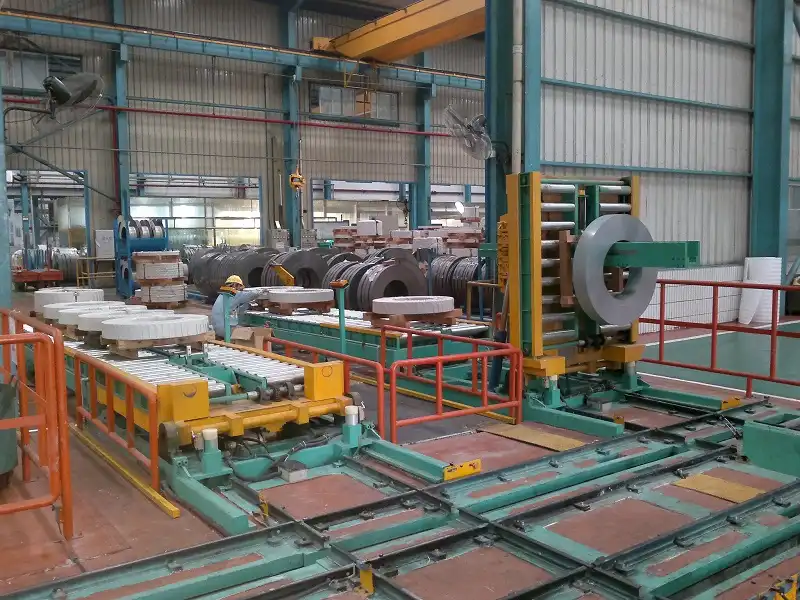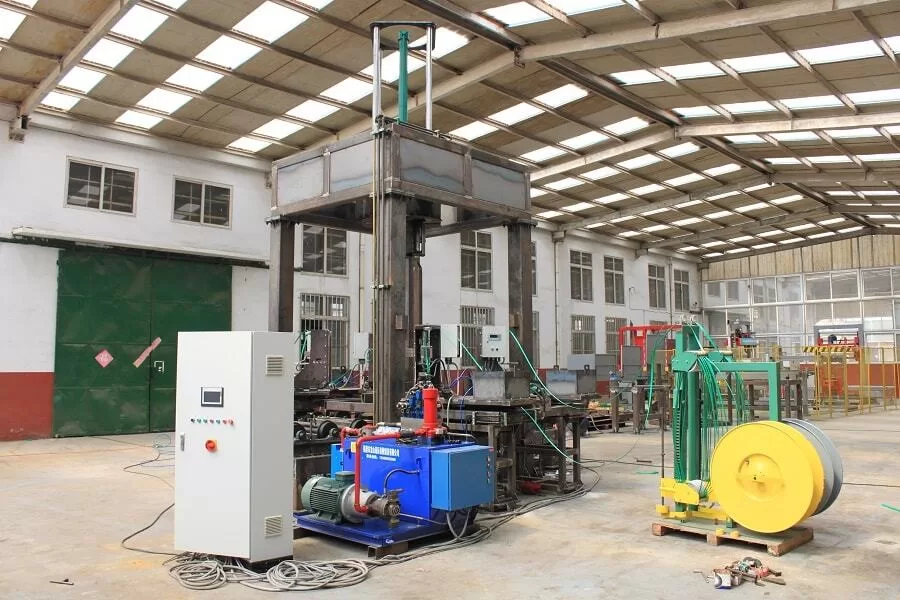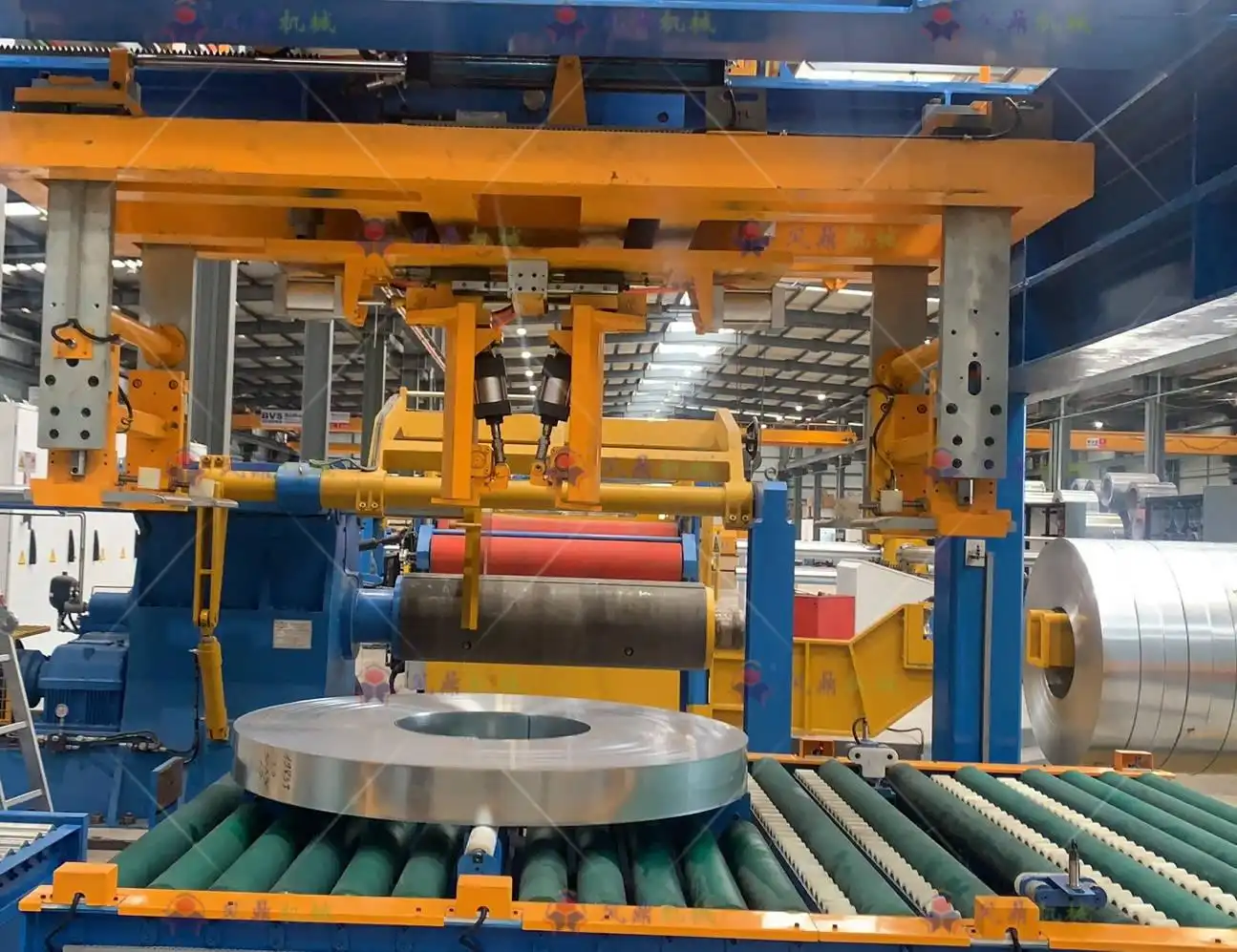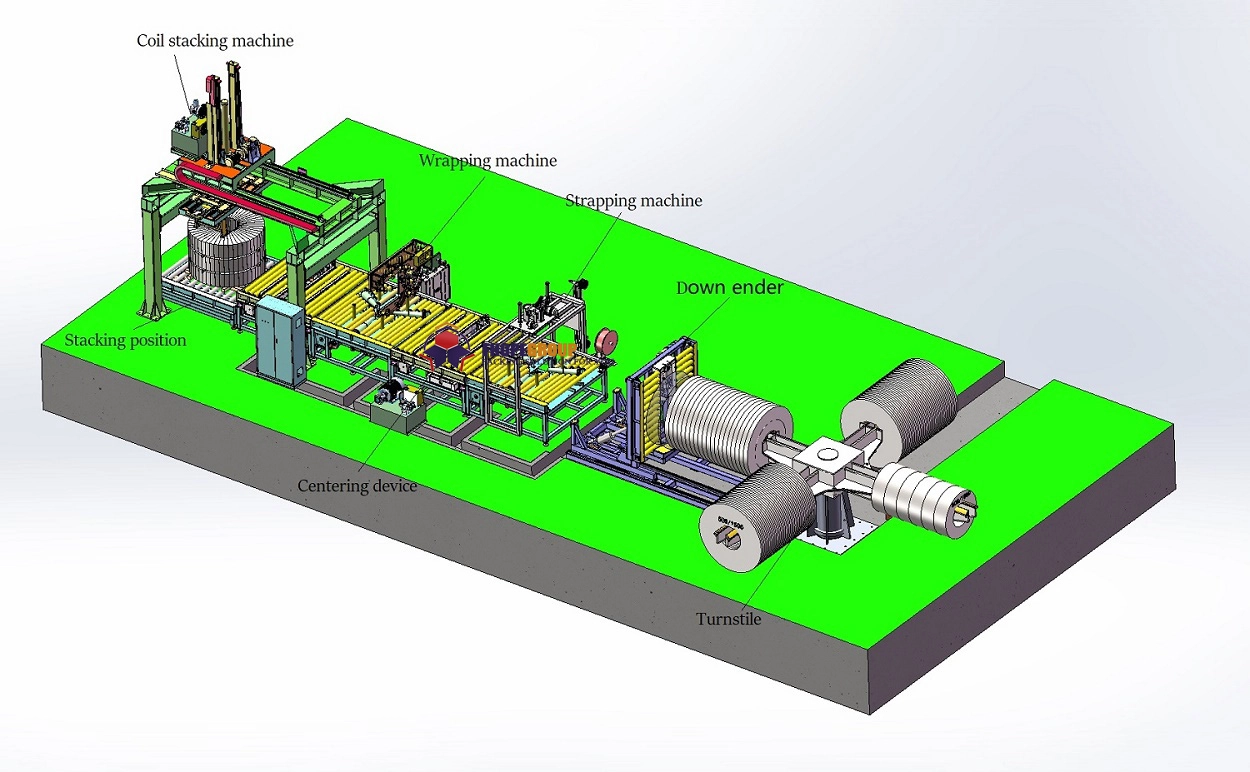Running a large steel mill is a constant battle against razor-thin margins. You face volatile energy prices, aging equipment that threatens costly downtime, and increasing pressure to meet environmental standards. Making a major investment in a new coil packaging system feels like a huge risk. A wrong choice can lock you into years of inefficiency and high operational costs, hurting your bottom line instead of helping it. But what if you could invest with confidence, knowing the system was built not just to work, but to solve your biggest challenges and drive your business forward? As someone who has been on both sides—as an engineer on the factory floor and as a factory owner myself—I understand these pressures intimately. The right features can transform your packaging line from a cost center into a strategic asset.
The most critical features modern coil packaging systems must have include advanced automation for cost reduction, deep IoT integration for data-driven decisions, modular design for future flexibility, and a supplier relationship built on a true strategic partnership. These elements work together to increase uptime, lower operational costs, and provide the adaptability needed to thrive in a fluctuating market.

I have spoken with many factory owners, like Javier from Mexico, who manage massive operations and face these exact challenges. They are not just buying a machine; they are investing in the future stability and profitability of their company. They need more than just technical specifications on a brochure. They need to know how a new system will concretely address their goals: boosting uptime to 95%, cutting energy use, and lowering overall costs by 8% or more. In this article, I want to walk you through the features that matter most, based on my years of experience designing these systems and helping clients grow their businesses.
How Can Advanced Automation Reduce Long-Term Operational Costs?
You see the numbers every month. Labor costs rise, and energy prices swing unpredictably, making it hard to forecast your production costs accurately. You rely on your team, but manual or semi-manual packaging processes can lead to inconsistent wrap quality, material waste, and, most importantly, safety risks for your people. An older, inefficient machine might seem like it's saving you money upfront, but it's quietly draining your profits through high energy consumption and frequent maintenance. This constant financial drain makes it difficult to invest in other areas of your business.
Advanced automation directly reduces long-term operational costs by minimizing the need for manual intervention, optimizing the use of packaging materials, improving workplace safety, and significantly lowering energy consumption through high-efficiency motors and intelligent, on-demand power usage. It creates a predictable, stable, and cost-effective packaging process.

When I first started my own factory, controlling operational costs was my single biggest worry. Every dollar saved on the production line was a dollar I could reinvest in growth. This is where I saw the true power of automation. It’s not about replacing people; it's about empowering your team to do more valuable work while the machine handles the repetitive, physically demanding tasks with perfect consistency. Let's break down how this translates into real savings for a large-scale operation.
From Labor-Intensive to Labor-Optimized
In many older steel mills, coil packaging is a multi-person job. It involves manually feeding packing material, positioning the coil, operating the machine, and then moving the finished product. This is not only slow but also exposes your team to potential safety hazards. A fully automated system integrates these steps. Conveyors move the coil into position, sensors confirm its dimensions, and robotic arms or automated guides feed the wrapping material. The wrapping, strapping, and labeling happen without a single person touching the coil. This doesn't mean you need fewer employees. It means you can reassign those skilled workers from manual labor to more critical roles like quality control, machine supervision, and maintenance planning, increasing the overall productivity of your plant.
Slashing Material and Energy Waste
Every meter of wasted stretch film or wrapping paper is a direct hit to your profit margin. Manual application is rarely perfect. Sometimes too much material is used; sometimes not enough, leading to product damage during shipping. An automated system is programmed for precision. It uses sensors to measure the coil and applies the exact amount of material needed for a secure wrap, every single time. This consistency can reduce material consumption by 15-20% or more. Similarly, modern machines are designed for energy efficiency. They use variable frequency drive (VFD) motors that only draw the power needed for the task at hand, unlike older machines that run at full power constantly. They also have "sleep" or "standby" modes that power down non-essential components between cycles, directly addressing the challenge of volatile energy costs.
A Look at the Real-World Impact
To make this clear, let's compare a traditional, semi-manual process with a modern, fully automated one for a steel mill.
| Metric | Semi-Manual Packaging Line | Fully Automated Packaging Line | Impact |
|---|---|---|---|
| Operators Required | 2-3 per shift | 1 (Supervisor) | >50% reduction in direct labor |
| Material Waste | 10-15% | <2% | Significant material cost savings |
| Energy Consumption | Constant high draw | On-demand, VFD controlled | 20-30% lower energy bills |
| Cycle Time per Coil | 3-5 minutes | 1-2 minutes | Increased throughput |
| Uptime / Reliability | Prone to human error | Consistent, predictable | Higher asset utilization |
The numbers speak for themselves. The initial investment in automation pays for itself not just in labor and material savings, but in increased throughput and reliability, which are key goals for any factory owner.
What Role Does Data and IoT Integration Play in Modern Packaging Lines?
As a factory owner, you know the frustration of unexplained downtime. A critical machine stops working, and your entire production schedule is thrown into chaos. You ask what happened, but the machine itself gives you no answers. It's a "black box." You have to rely on maintenance crews to diagnose the problem reactively, which takes time and costs money. This lack of visibility makes it impossible to plan effectively or to move from a reactive maintenance model to a proactive one. You can't achieve a 95% uptime goal if you are constantly surprised by equipment failures.
Data and IoT integration transform a packaging line from a standalone machine into an intelligent, communicative asset. It provides real-time data on performance, tracks energy usage, monitors component health to enable predictive maintenance, and connects seamlessly with your plant's MES or ERP system for complete, factory-wide operational visibility.

When I was helping a major steel producer upgrade their facility, their biggest complaint was unplanned downtime. Their packaging line was a bottleneck. We didn't just propose a faster machine; we proposed a smarter one. We installed IoT sensors on all critical components—motors, bearings, rollers, and pneumatic systems. This data was fed into a simple dashboard that gave the plant manager a clear view of the machine's health. This is the essence of digital transformation, a key goal for forward-thinking owners like Javier. It’s about using information to make better decisions.
From Reactive to Predictive Maintenance
The biggest shift that IoT enables is the move from reactive to predictive maintenance. In a traditional setup, you fix things when they break. Or, you follow a time-based schedule, replacing parts whether they need it or not, which can be wasteful. With IoT sensors, you move to condition-based maintenance. For example, sensors can detect subtle increases in a motor's vibration or temperature. This is often a sign of a bearing that is starting to fail. The system can send an alert to your maintenance team weeks before the failure actually happens. This allows you to schedule the repair during a planned shutdown, avoiding a costly line stoppage. This is how you realistically push your equipment's effective run time towards that 95% target.
Integrating with Your Factory's Brain (MES/ERP)
A modern packaging line should not operate in isolation. It is the final step in your production process. Integrating it with your Manufacturing Execution System (MES) or Enterprise Resource Planning (ERP) system is crucial for achieving total production visualization. When the packaging line is connected, it can automatically receive information about the coil that is arriving—its grade, dimensions, and customer order. It can then apply the correct packaging recipe without manual input. After wrapping, it can send data back to the ERP, confirming the coil is finished and ready for shipment, which automatically updates your inventory. This seamless flow of information eliminates data entry errors and gives management a real-time view of the entire production process, from steelmaking to shipping.
Key Data Points and Their Business Value
Let's get specific about what data you should be looking for and how it helps your business.
| Data Point from IoT Sensor | Business Impact | Key Goal Addressed |
|---|---|---|
| Motor Vibration/Temperature | Predicts bearing/motor failure before it occurs. | Increase Uptime, Lower Costs |
| Cycle Time per Coil | Identifies bottlenecks and process inefficiencies. | Improve Throughput |
| Power Consumption (kWh) | Tracks real-time energy use, identifies waste. | Reduce Unit Energy Consumption |
| Material Tension/Usage | Ensures consistent wrap quality, minimizes waste. | Lower Costs, Improve Quality |
| Fault Codes & Alerts | Provides instant, specific diagnostic information. | Reduce Downtime (MTTR) |
This level of insight allows you to manage your packaging operation with the same analytical rigor you apply to your finances or your production scheduling. It turns guesswork into certainty.
Why is Modularity and Customization Non-Negotiable for Market Fluctuations?
Your customers' needs are always changing. One year, the automotive sector demands smaller, lighter coils. The next, the construction industry needs larger, heavier ones. Your product mix is not static. If you invest in a rigid, one-size-fits-all packaging line, you are handcuffing your business. When a new type of order comes in that your machine can't handle, you are forced to either turn down the business or resort to slow, expensive manual workarounds. This lack of flexibility makes it impossible to respond to market opportunities and can quickly make your expensive new equipment obsolete.
Modularity and customization are non-negotiable because they give your packaging line the ability to adapt. A modular system allows you to easily add, remove, or change components to handle different coil sizes, new packaging materials, or increased production demands, protecting your investment and ensuring your factory can stay agile in a changing market.

I remember a client in the steel service industry who faced this exact problem. They bought a standard packaging line, and it worked well for their main product. But six months later, they won a major contract that required a different type of wrapping material and a special labeling process. Their existing machine couldn't do it. The cost to retrofit it was enormous. This experience taught me a valuable lesson: you must plan for the business you want to have in five years, not just the business you have today. A modular approach is the key to that kind of future-proofing.
Designing for Change
What does a modular system actually look like? Imagine it as a set of building blocks. The core of the system is the main wrapping unit. But everything around it can be a separate module. You might have:
- An in-feed conveyor module.
- A coil tilting module.
- A strapping module (which could be steel or PET).
- A labeling module.
- An out-feed and stacking module.
If your needs change, you don't have to replace the entire line. If you need to add strapping, you can integrate a strapping module. If you need to handle much larger coils, you might only need to upgrade the conveyor and tilter modules, while keeping the core wrapping unit. This "plug-and-play" approach makes your operation much more agile.
Balancing Customization and Standardization
While customization is vital, it must be balanced with standardization. You don't want a machine that is so unique that finding spare parts is a nightmare. This is where the partnership with your supplier is critical. A good supplier will build a custom solution for you using their standard, proven modules. This gives you the best of both worlds: a line that is tailored to your exact needs, but built with reliable, readily available components. This approach significantly reduces long-term maintenance costs and ensures that you can get spare parts quickly when you need them.
Comparing System Architectures
The difference between a rigid and a modular system becomes very clear when you look at the long-term implications.
| Aspect | Rigid, One-Size-Fits-All System | Modular, Customized System | Advantage of Modularity |
|---|---|---|---|
| Initial Cost | May be slightly lower | May be slightly higher | - |
| Adaptability to New Products | Very low, requires major re-engineering | High, add/swap modules | Can seize new market opportunities |
| Cost to Upgrade/Scale | Extremely high, often requires full replacement | Moderate, incremental cost | Protects initial investment |
| Long-Term ROI | Diminishes as market changes | Stays high due to flexibility | Better financial performance |
| Resale Value | Low, specific to original purpose | Higher, can be reconfigured | Better asset management |
For a forward-thinking owner like Javier, who understands business cycles and market volatility, investing in a modular system is not just an equipment decision; it is a strategic business decision that ensures long-term competitiveness.
My Insights: The Most Important Feature Isn't a Feature at All
You have seen the technical specifications. You have heard the sales pitches about automation, IoT, and modular design. They all sound promising. But as a fellow factory owner, I know the question that keeps you up at night: "How do I know this will actually work for my factory, with my team, and my specific challenges?" A machine, no matter how advanced, is just a collection of steel and wires. The wrong supplier can deliver a perfect machine that still fails to solve your problems because they don't understand your operational reality.
The most important feature of any new equipment investment is not found on a spec sheet. It is the quality and depth of the strategic partnership you build with your supplier. You need a partner who has walked in your shoes, understands the immense pressure of your role, and is committed to your long-term success, not just making a one-time sale.

I've Been There
Before I started SHJLPACK, I was an engineer. Later, I took the leap and built my own factory. I remember the feeling of signing a check for a huge piece of equipment. It was terrifying. I knew that my company's future depended on that machine running smoothly and delivering the ROI I promised my bank and my partners. I made mistakes. I once chose a supplier based on the lowest price, and it was a disaster. The machine had constant issues, and getting support was a nightmare. That experience taught me more than any engineering textbook. It taught me that the people behind the machine are more important than the machine itself. This is why our mission at SHJLPACK is to be a knowledge-sharing platform first, and a manufacturer second. We want to give back and share what we've learned to help others avoid the mistakes I made.
What a Strategic Partnership Really Means
A true strategic partner does more than just sell you a machine. They are with you for the entire journey.
- During Selection: They listen to your problems—high energy costs, aging equipment, market pressures—and help you design a solution that directly addresses them. They don't push a one-size-fits-all product.
- During Installation: They work with your team, on your factory floor, to ensure the integration is seamless. They provide comprehensive training so your operators and maintenance crew feel confident and capable from day one.
- After Launch: They provide ongoing support, not just for spare parts, but with advice. They can help you analyze the data from your new IoT-enabled line and suggest process improvements. They can offer advice on digital transformation and meeting new environmental standards, just as Javier expects.
This is a relationship built on trust and shared success. Your success is their success.
Ask the Right Questions
When you are evaluating a potential supplier, don't just ask about the machine's speed or power. Ask these questions instead:
- "Can you share a story about a client who had a problem similar to mine? How did you help them solve it?"
- "What does your after-sales support look like in the first year? What about in year five?"
- "How will you help my team get the most out of the data this machine produces?"
- "Have you worked with factories that need to comply with the environmental regulations we face?"
The answers to these questions will tell you everything you need to know. They will reveal whether you are talking to a simple vendor or a true strategic partner who is invested in helping you grow your business.
Conclusion
A modern coil packaging system needs automation, data, and flexibility. But most importantly, it requires a strategic partner committed to your long-term success and delivering a total solution, not just a machine.





